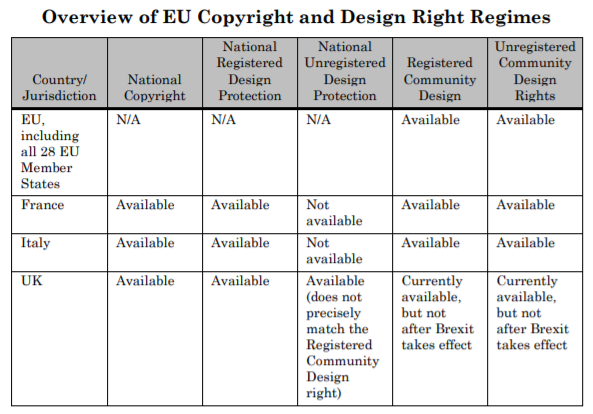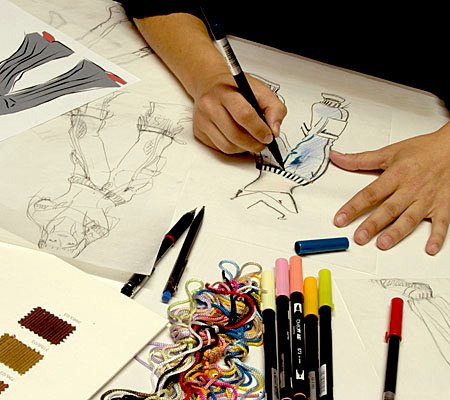This article has been written by Shradha Jain, pursuing the Diploma in Intellectual Property, Media and Entertainment Laws from LawSikho.
Table of Contents
Introduction
Europe is the birthplace of some of history’s most significant textile and fashion inventions, as well as a number of the most renowned designers, producers, inventors, and artists, like Coco Chanel, Giorgio Armani, and Christian Dior, to mention a few. According to the most recent available data from 2017, the EU textile and apparel sector employs approximately 1.7 million people directly in over 175,000 firms, with a turnover of EUR 181 billion. However, the fashion business must also deal with significant challenges such as: -counterfeiting, knock off, and unfair competition. In this scenario, developing an effective IP strategy and taking a proactive approach to protecting your fashion business becomes critical. Indeed, its intellectual property system provides adequate protection for these challenges. In this article, we will explore the two intellectual property rights, copyright and industrial design right, which are the most relevant to fashion design, and the copyright laws of a few European nations to get a brief overview of the protection system that persists across the continent. 
Fashion designs and design protection
There are two types of design protection: registered and unregistered, we shall take a look at both briefly.
Registered community design
The European Union developed a unified approach to design rights protection that has been supported by the 28 EU Member States (i.e., the various countries that make the EU), by first enacting the EU Designs Protection Directive (98/71/EC) (hereafter referred to as the “EU Directive”). The European Union Directive National design protection regimes across the EU have been standardised by the compelling member States to protect “designs” through registration and define design as “the look of the entire or a part of a product deriving from the features of… the lines, contours, colours, shape, texture… or its ornamentation…” To be eligible for protection, the design must be “novel” and have “individual character.” In this context, “novelty” denotes that no similar designs are already offered to the public. A design has “individual character” if “the overall impression, from the perspective of an informed user, differs from other designs available to the public.”
A registered community design application can be filed directly with the EUIPO office. An EU design can also be registered by submitting an international application under the Hague System and naming the European Union or the individual EU Member States in order to secure design protection in their respective jurisdictions. The Hague system is an international design registration system administered by the World Intellectual Property Organization (“WIPO”) that allows the owner of a design to file a single international application and designate more than 66 countries that have acceded to the Hague system.
Countries enact laws, if not already in force, to protect designs through registration and to grant owners exclusive rights for a period of five years from filing, which can be extended for a further five years up to a maximum of twenty-five years. The design directive left the specific protection mechanism to the legal systems of the individual European states and allowed the countries to accumulate legal protection for design, so that France, for example, continues to offer two simultaneous protection options for designs: copyright and the necessary registered design rights. EU states that have not protected their designs under copyright could comply with the designs directive by only offering the necessary minimum design protection.
Unregistered community design
Following its design right directive, the EU issued EU Regulation 6/2002 (the “EU Regulation”), which expanded the protection of what was then known as the Community design right to encompass both registered and unregistered rights. While registered design rights were already included in the EU Designs Protection Directive, EU Regulation 6/2002 included a new sui generis design right for unregistered designs in the EU. The Regulation provides protection for three years from the moment the design was first made available to the public within the EU. This time frame is limited and cannot be extended. The term “disclosure” is used in the regulation to denote the act of making the design available to the public, which is the primary prerequisite for protecting an unregistered community design. The protection of an unregistered community design requires the same requirements as for registered designs. The difference between them, however, is that registered designs are protected against identical designs. Even in the event of a bona fide infringement, unregistered designs can only be protected if the infringing act was carried out in bad faith. However, unregistered designs are well suited to protect “short-lived products (e.g., products of the fashion industry)”, as the registration process can be long and expensive.
Karen Millen versus Dunnes Stores
This is one decision that has been celebrated by the owners of fashion design rights. In January 2007, popular British brand Karen Millen filed a lawsuit against Dunnes Stores over unregistered EU design rights to their clothing and initiated injunctive and damages proceedings. Dunnes Stores appealed and the Supreme Court referred two points to the Court of Justice of the European Union (“CJEU”) that ultimately led to the finding that-
- the overall impression a design makes on a user must be different from that of a design or designs have taken individually be, in contrast to a mixture of hand-picked features from several already existing designs and
- that the rights holder does not have to prove the individual character of the unregistered EU design in infringement proceedings; the rights holder only needs to specify the features that provoke the individual character of the design.
|
Registered Community Design |
Unregistered Community Design |
|
|
Formality |
Application and registration |
Automatic protection |
|
Cost |
Yes |
No |
|
Scope |
Protected against the identical and similar designs |
Protected only against the “dead copy” |
|
Border control |
Yes |
No |
|
Duration |
Maximum of 25 years from the date of application |
3 years from the date of publication in EU |
Fashion designs and copyright protection
The copyright law aims to protect creativity and then to establish freedom of expression, regardless of the form used. The most important element of copyright law is that it protects the expression of the idea, the implementation, and not the idea itself. In particular, ideas cannot be protected under copyright law as this could distract creativity and innovation.
Origin of copyright law for fashion designers
Copyright protection in Europe stretches back to the 17th century in the United Kingdom, and it arose from the necessity to preserve linens and cotton. Regulation has evolved over time, and it has been expanded to include more fashion goods as well as to meet the criteria of the European Union. The foundation of copyright law, as a tool against design piracy, can be found in the Berne Convention. It is necessary that “A member state extends to nationals of other member states the same copyright protection that it extends to its own nationals.” The Berne Convention specifies the minimal standards for the national copyright laws of the member countries.
Copyright protection is provided by the national legal systems of each Member State. The member states are responsible for setting the conditions for this protection and its levels, which means that each member state has its own conditions for copyright protection (others stricter and others with lower standards) but still under harmonization of the EU Copyright Directives. Copyright protection is automatic, that is, no formality is required to protect the author, it is assumed that the person who creates a work will become its author, and will also get the protection of the law if his/her creation is original.
Infopaq International A/S versus Danske Dagblades Forening
It is the most important case on the criterion of originality within the EU. In addition to other rulings on the specific case, the CEJU pointed out that “only the original works of art, in the sense, that they are the “intellectual creation of the author” are matters of copyright protection”, emphasizing that this is the only criterion that applies to all EU Member States and all types of works regardless of their form. This means that there is a completely uniform criterion for all EU Member States preventing them from using their national legal systems to define originality. According to this, only “original” works, in the sense that they are their “author’s own intellectual creation,” expressing his/her own personality and uniqueness, are protected by copyright law; any other work – not original – may be protected by other laws, but not by copyright law.
France
France’s copyright system has historically protected fashion designs, as it is home to some of the world’s most prestigious haute couture fashion firms. Article L 1121 of the French Intellectual Property Code (the “IPC”) protects original works of the mind, including those that “reflect the personality of their author,” and expressly lists “creations of the seasonal garment and clothing business” as a work protected from the mind in Article L 1122. The challenge for design owners is to demonstrate the originality of their designs, as fashion designs tend to follow current trends and thus may lack originality. Design that may be seen as commonplace in France is protected not only by national copyright law but also by EU design rights sui generis, as discussed above.
Italy
Like France, Italy protects fashion designs under its national copyright system. The Italian Copyright Law (the “LDA”) protects “intellectual works that have a creative character and belong to literature, music, the performing arts, architecture, theatre or cinematography, regardless of their nature or expression, are protected according to the provisions of “this law”, and “in particular, protection extends to … industrial design works that are of a creative or inherent artistic character.” Copyright protection is not dependent on registration; under the LDA, fashion designers can seek an ex parte interim injunction from the Italian courts to confiscate any copy of their designs with creative and aesthetic merit, and subsequently, ask for a permanent injunction and damages for unregistered works. The copyright of a designer lasts for the duration of the designer’s life plus 70 years after the designer’s death. Fashion designs can also be protected by Italian national design protection and European design protection since the Italian Industrial Property Code (“CPI”) protects designs registered with the Italian Patent and Trademark Office (“IPTO”), and any applicable international design registries.
United Kingdom
In the United Kingdom, copyright law is governed by the Copyright, Designs, and Patents Act 1988 (“CDPA”). Original “artistic works” are automatically given copyright protection in the UK. “Artistic works” are defined in the CDPA as “a graphic work, photograph, sculpture or collage, regardless of its artistic quality, an architectural work that is a building or a model for a building, or a work of artistic craftsmanship”. Fashion designs are included in the “Crafts” category. However, case law reveals that there is a high hurdle for demonstrating that a work is of creative workmanship, making it difficult to obtain copyright protection for fashion designs. According to the CDPA, if work is considered “general” at the time of its creation in the field of design in question, it is not “original” within the meaning of design law.

Design and copyright protection : cumulative but not equal
In theory, an item can be protected as a registered design, formerly a design patent as well as under copyright protection at the same time. This could be significant because the protection classes differ in terms of both the breadth of protection and the running time. Copyright protection is typically effective for up to 70 years after the death of the relevant author, while registered design protection expires after 25 years at the most.
Essential differences
- In copyright law, the concept of “visual overall impression” does not exist, as it does in design law.
- Different assessments of exclusive rights violations.
- Design protection shields investments in the production of designs against rivals’ replication.
- Copyright has a low originality barrier, therefore every item made counts.
Conclusion
Fashion designers and corporations must be aware of the disparities in intellectual property laws for fashion design in the European Union. The European Union and some of its member states offer fashion designers broader intellectual property protection, which is reflected in Europe’s reputation as a fashion hub and prominent region for haute couture fashion houses. The copyright protections afforded by national legislation in France, Italy, and the United Kingdom are distinct from the sui generis design rights recognised by EU Regulation 6/2002 and the EU Designs Protection Directive (98/71/EC). While a designer can choose to protect their designs under a single regime, cumulative protection is possible. As a result, dual protection (copyright and design protection) over a fashion design may occasionally perplex judges, causing them to mistake the novelty requirement for design protection with the originality requirement for copyrights. However, care must be taken to recognize the distinction between copyright and design protection and not to combine the “originality” requirements of copyright law with the “novelty” and “individual character” requirements of design law.
References
- https://www.wipo.int/edocs/mdocs/mdocs/en/wipo_ipr_ge_15/wipo_ipr_ge_15_t2.pdf
- https://www.inta.org/wp-content/uploads/public-files/resources/the-trademark-reporter/vol107_no6_a1_montalvo_witzburg.pdf
- https://onlinelibrary.wiley.com/doi/full/10.1111/j.1744-1714.2010.01111.x
- https://core.ac.uk/download/pdf/236155843.pdf
- https://cardozoaelj.com/2016/12/01/protecting-fashion-comparative-analysis-fashion-design-protection-united-states-europe/
- https://legal-patent.com/design-law-en/design-protection-and-copyright-protection-also-for-fashion/
- https://www.wipo.int/edocs/mdocs/mdocs/en/wipo_ipr_ge_15/wipo_ipr_ge_15_t2.pdf
Students of LawSikho courses regularly produce writing assignments and work on practical exercises as a part of their coursework and develop themselves in real-life practical skills.
LawSikho has created a telegram group for exchanging legal knowledge, referrals, and various opportunities. You can click on this link and join:
 Serato DJ Crack 2025Serato DJ PRO Crack
Serato DJ Crack 2025Serato DJ PRO Crack










 Allow notifications
Allow notifications



